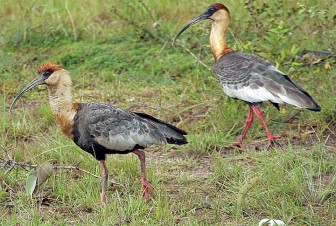The Buff-necked Ibis (Theristicus caudatus) is a large, handsome bird which can be regularly seen in the North Rupununi savannahs, especially at Bina Hill, perched on the thatched roofs, and around the Rock View airstrip foraging in the savannah.
The species is restricted to the tropics, especially the warmer sub-tropics, and has a preference for open spaces, especially savannahs, grasslands, fields and marshes.
![]() The Buff-necked Ibis is a bird species whose population is slowly returning to the North Rupununi; it is believed that the species population declined due to overharvesting. They are a species that has a wide range and exists from Colombia, Venezuela, the Guianas and Brazil; the current population is believed to be stable by the IUCN and is therefore is listed as “least concern.”
The Buff-necked Ibis is a bird species whose population is slowly returning to the North Rupununi; it is believed that the species population declined due to overharvesting. They are a species that has a wide range and exists from Colombia, Venezuela, the Guianas and Brazil; the current population is believed to be stable by the IUCN and is therefore is listed as “least concern.”
 The Buff-necked Ibis is 75 cm long. It has a buff neck, the upper parts are grey, and the feathers of the belly and flight feathers are black, while there is a large white patch of feathers on the wings. The bird has distinct red legs and a distinct downward curving beak. The bill and bare skin around the eyes are black. Its squeaky caw can be heard when it is in flight or when alarmed.
The Buff-necked Ibis is 75 cm long. It has a buff neck, the upper parts are grey, and the feathers of the belly and flight feathers are black, while there is a large white patch of feathers on the wings. The bird has distinct red legs and a distinct downward curving beak. The bill and bare skin around the eyes are black. Its squeaky caw can be heard when it is in flight or when alarmed.
The species like to forage in areas where the soil is soft, and their diet consists of insects, spiders, frogs, reptiles, snails, other invertebrates and small mammals. The species is believed to build nests made of twigs and branches in trees.
During the breeding season it is believed that the mating pair carry out a mating ritual that includes bill popping and passing of twigs back and forth, and the female lays between 2 to 4 eggs.
Rain forests are rich in biodiversity and are home to many different plants and animals as well as indigenous communities. Humans, even those who don’t live in the rain forest, rely on it for resources such as building materials (wood and lianas), medicine and fruits. Rain forests also provide essential environmental services for life on earth; they create soil as well as prevent soil erosion, produce oxygen though photosynthesis, maintain clean water systems, and are a key defence against climate change.
The Iwokrama Rain Forest is 371,000 hectares, located in the heart of Guyana. Our mission is to develop strategies for conservation and sustainable development for local people in Guyana and the world at large. We are involved in timber, tourism and training. Come and visit us in the rain forest or at http://www.iwokrama.org.





